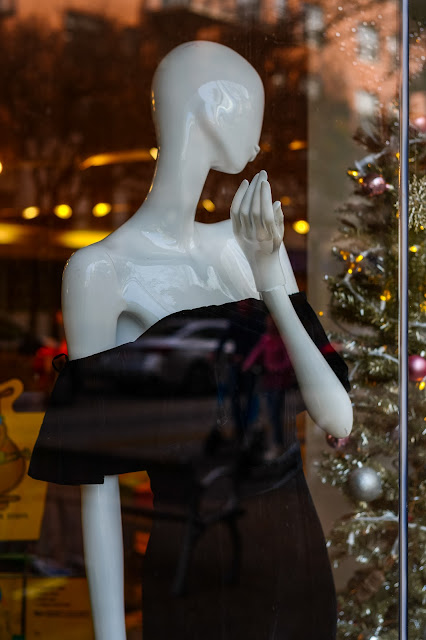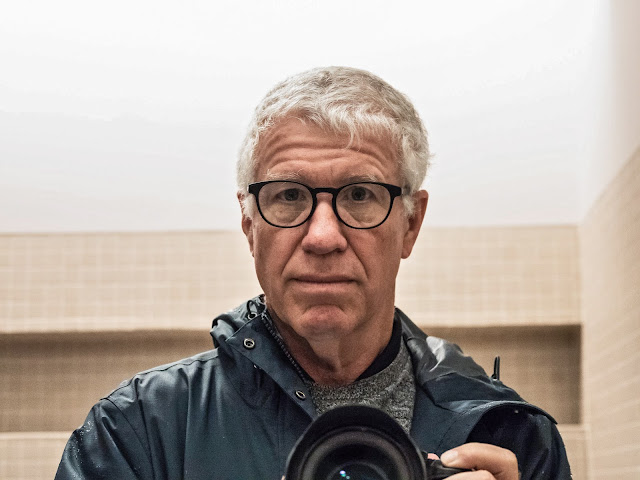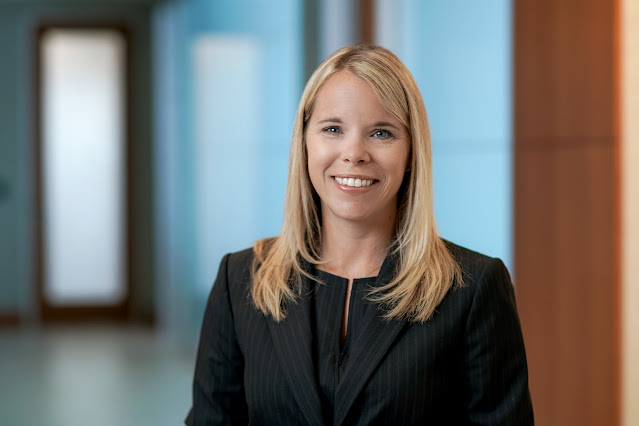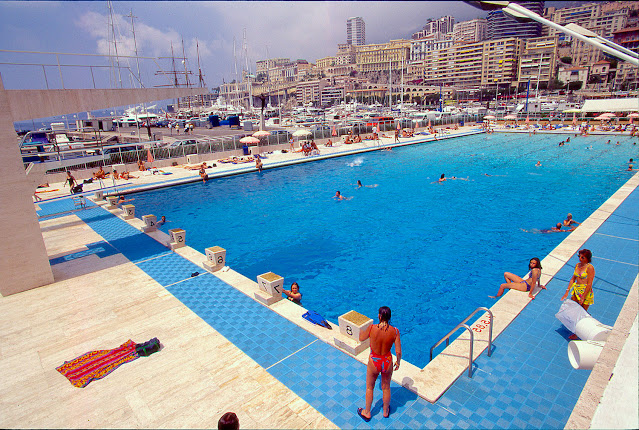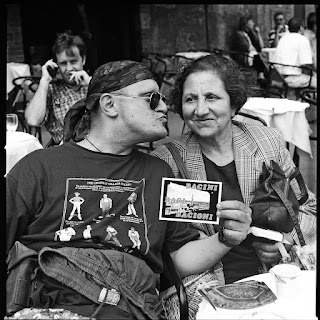12.31.2022
Looking backwards. Looking forward. It's all good.
Getting up to speed with a really nice combination of camera and lens. Sometimes you just have to get out and shoot a lot of frames to get comfortable with gear.
12.30.2022
I just finished the post production on the very last big portrait project of 2022. I photographed people for a national accounting firm. Adobe is making it easier and easier to do great color grading and retouching for environmental portrait work.
There is one thing I do know. I really like making portraits for people. I'm not a fan of the "factory headshot" production method of herding a never-ending line of people onto a gray or blue seamless background and trying to get everyone through quickly, although I did a lot of that in the 1980s and 1990s. More recently I've worked toward a style, or a family of styles, that clients seem to really like and prefer. Even if the process is slower and less client controlled.
12.28.2022
The Leica CL was an underappreciated camera system. But it does, in some ways, repudiate the idea that everyone wants smaller and lighter cameras.
I bought a CL camera last year and I use it mostly with third party lenses; some of them completely manual and some AF lenses from Sigma and Panasonic. The camera is small and relatively light. At least compared to the SL cameras with which it shares a lens mount standard. Just before the start of the holidays I bought a 16mm f1.4 Sigma Contemporary lens in the L mount that was aimed specifically for these kinds of APS-C camera bodies. That lens completed my well rationalized (for me) collection of Sigma AF lenses for the CL system. The lens line also included the 30mm f1.4 and the 56mm f1.4. All fast. All very good performers. All relatively inexpensive. The 18-50mm Sigma zoom is the one stop shop for focal lengths and it's quite good as well.
In the days of film cameras the film itself was the "sensor" and the "color science" was separate from the camera itself. You might like the way a film camera worked but you could duplicate the color or look with any similar camera from another brand by choosing to photograph with the same film and by processing the film in the same way.
Leica's marketing in that era was aimed at convincing photographers that Leica lenses were made to much higher standards than lenses from competitors and so the reason to buy Leica cameras was for the ability to use these great lenses. Leica was thought by its adherents and fans to use better and more expensive glass elements and also to have a greater mastery of lens manufacturing and tighter tolerances than the other guys.
While their lenses are still considered by many to be class leading the real reason for me to photograph with Leica cameras now hinges on the opposite marketing proposal. One that says Leica's color science is the most desirable. These observations are related to which family of Leica cameras one uses. I'm partial to the whole L mount concept, even working comfortably with different bodies from each of the three signatories of the L mount alliance. I have used an M8, an M9 and an M10R Leica rangefinder bodies and I found them an odd mix-and-match solution for the digital age but I have had much deeper and more satisfying day-to-day experiences with the Leica SL, SL2, CL, TL2, Sigma fp and various Panasonic S system cameras. My observations about color science are mostly about what Leica's L mount cameras bring to the table. Specifically the CL.
The CL is a modern, digital Leica which shares its file looks, Jpeg output and raw file potentials, in part, with the SL and the SL2 cameras. In the standard setting profiles the cameras all deliver skin tones that are not oversaturated and have have a neutral color balance when the WB is set correctly. They create images with a perceptual sharpness that's different than other makers' cameras. There is what seems to be a higher level of acuity and, at the same time, greater very fine detail and texture. At the neutral settings this does not give the appearance of files that have been over-sharpened but instead the look is of something that's sharp the way we see things in the "real world." At the same time the noise from these Leicas, when used at higher ISOs, is more monotone and plagued by fewer chromatic aberrations and color noise.
I find the raw files from the SL2 and the CL easier to correct and bring to a neutral look than I have found in the past with my Sony and Nikon cameras. Canon cameras seem to be the easiest to use if getting "pleasing" color is the top priority. But with Leica's raw files, across those two cameras, the process of getting pleasant color from each is fairly straightforward. And the image structure is more compelling to me than that delivered by Canons I have used.
Getting the color and contrast of a file right is important. But so it usability of the product across the range of bodies and lenses.
This is a big plus for the L mounts. I like the fact that purchased lenses can be used across a wide range of L mount cameras. I can use, for example, the 24mm f3.5 Sigma i-Series lens as a 35mm AOV equivalent on the CL or use its full frame coverage with a full frame camera and get really good results in each scenario. Likewise I can put a 16mm APS-C lens on an SL2, use the crop mode in the camera and get a nice, perfectly usable 22 megapixel file from that camera. My brilliant 65mm Sigma lens turns into a super-sharp and compelling 90mm equivalent portrait lens on a CL. Switching zooms between the two formats offers the same changes in angle of view.
One might question the use of APS-C lenses on a full frame camera like the SL2 but they can be great tools for videographers who want to get absolutely the best video performance by using the cropped frame for faster focusing and more depth of field. Or higher frame rates. They also provide more depth of field for the same angle of view. And a longer reach with longer lenses. I think of the switch to APS-C sometimes as having a built in tele converter.
The CL really comes into its own as a high quality, high portability system. Coupling the camera with a small selection of prime lenses, or with the Leica 18-55 zoom or the Sigma 18-50mm zoom lens give you a very compact but still powerful imaging system. I sometimes use the system when out hiking in the wilderness or exploring new urban environments during long walks. The system can handle almost anything but the highest resolution (SL2) or the lowest light levels (get a Lumix S5 or SL2-S). When I go out to shoot with intention and have opted to make one of the zooms my choice for the day I also bring along a second CL body and several really fast 3rd party prime lenses. Something like the TTArtisans 23mm f1.4. It's very small and performs well, even at wider apertures. Nice for people who like 35mm on FF. Another favorite is the Sigma 56mm f1.4. That gives me the equivalent of a fast 85mm with none of the bulk or weight.
What most appeals to me is the feel of the camera while I'm using it. It seems to fit my medium sized hands pretty well. That being said it turns into a even better handling camera when I add an accessory grip and an accessory thumb rest. Then the camera is almost an extension of my hand.
I understand that the big money in cameras has moved on from APS-C format. Even Fuji is hedging their bets by bringing out an ever growing mini-medium format system of cameras and lenses to appeal to people who really have fallen head over heels for the 35mm and larger formats. I get that Leica is a relatively small company and needs to concentrate on the areas in which it can show off its greatest strengths. The areas of expensive, very well designed lenses, and premium full frame cameras. The CL never achieved the glow of desirability that Leica seemingly bestows on its bigger cameras.
I'm disappointed to see Leica exit the smaller format (APS-C) market altogether. I like having the choices and since I work with cameras almost every day it's nice to have choices. It's nice to match as close as possible the camera to the intended usage.
Some people who bought into the CL system feel abandoned by Leica and resent that their lenses seem to be orphaned. It's hardly true. Right now a TL mount user (lenses that cover only APS-C but share the L mount) can put any of those lenses on a Leica SL2 or a Sigma fpL, switch the camera to APS-C mode and get nice 22 megapixel and 26 megapixel files that will squeeze every bit of quality from those lenses. Using the same lenses on lower res cameras like the S5 or the Sigma (original) fp camera gets you better low light performance than you'll get with the smaller format cameras. You give up resolution but you gain bigger pixels which give you less noise.
My hope, at this point, is that Panasonic will embrace the retreat of Leica from the APS-C market and see an opportunity to fill that vacuum for an APS-C system of their own built around the L mount. I'd love to see Panasonic come out with a rangefinder style camera, sporting a 24 megapixel sensor; or, even better, a 32 megapixel sensor that takes all of the lenses and let's users have a less expensive entry point into the system. By the same token, but even less likely, I'd love to see an APS-C version of the Sigma fp with an APS-C sensor and the addition of state-of-the-art IBIS.
I'm never 100% correct with my predictions but I think we're going to see a new camera or two from Panasonic, in the Lumix S line, and also a new camera or two from Leica. Sadly, I don't think either of them will be APS-C centric cameras.
I think we'll see a more advanced version of the S5 (probably calle an S6...) with a 40+ megapixel sensor and a vastly improved EVF. We'll probably see the newest Q camera from Leica with a bump up to a 60+ megapixel sensor, and an improved Lumix S1 with the same resolution as the previous model but with a stacked sensor and much more enhanced processing. It seems to be the one Panasonic camera that's pretty much perfectly sorted but just needs the final fine tuning of a second edition. I've so rarely seen that particular model (S1) on sale anywhere. Even now at what I'm guessing is near the end of its run.
I'd love to see a Leica Q camera with a 40 or 45 or 50mm lens on the front instead of the less useful 28mm. But it just doesn't feel like the moment for that one. We'll see how much luck Ricoh has with the GRIIIx and its 40mm equivalent lens. They may be the trendsetter when lens rationality is concerned.
It's time to see some fun variants in the L mount system. The L mount alliance.
Me? I'll mourn the loss of new CLs for a while but I'm always scouting for one more used body. Unless Panasonic comes out with an APS-C dedicated product for the system. A boy can always dream...
12.27.2022
Swimming in the great pools of the world. A counterpoint to the current weather...
The "Prince Rainier Memorial Pool" in Monte Carlo.
Bad luck here in Austin. The pool staff did a half-assed job of getting ready for our three nights of hard freezes and now we have some broken pipes that need to be repaired at the club. The water has been turned off. The repairs are supposed to start today. With divine intervention and fervent prayers (and payment of a large invoice) we hope the pool is swimmable for our masters practice tomorrow morning. I am an eternal pessimist when depending on others to get stuff done so I'm assuming the whole process will take the better part of the work week. The sad thing is that a bit more up front effort could have prevented this from happening in the first place...
But all this got me thinking about swimming, of course. And since I was already going through a folder of images from scanned slides coincidence conspired to toss in the image above just to rub my nose in my "no swim practice" dilemma.
I worked on a week long corporate project back in the late 1990's for a prosperous software company. They had high hopes that if they did a five star show in a cool place like Monaco their EU clients would be so impressed. Even with "A" list speakers and great planned dinners, etc. attendance was a fraction of what the client expected. They shortened their program from full days to half days, supplemented by lots of golf, sightseeing, etc. But for "below the line" people like me it meant, mostly, mid-afternoon to early evenings with lots of free time. I immediately researched swimming pools within walking distance....
The Prince Rainier Pool is a 50 meter pool situated right in the midst of the harbor area. It's maybe 50 feet from the dockside. Gorgeous yachts everywhere. The water was perfectly clear and kept safe via salt treatment instead of chlorine. The only downside was no lap lanes and no lane lines so dodging kids and slow moving swimmers became part of the entertainment. I can't remember exactly but I seem to recall that admission was $2. A bargain for one of the nicest pools I've been in.
It was late Spring. The weather was perfect. The pool was maybe a twenty minute, brisk walk from the Loews Beachfront Hotel, which was adjacent to the Grand Casino. The better bet was always the swim.
Did I have a swim suit and goggles? You might as well ask if I breath oxygen.
I have fond memories of five really nice, laid back swims in the Monte Carlo pool. And also nice memories of nice cappuccinos on the balcony of my room afterwards. Traveling with corporate officers is always a nice way to see the world. A bit skewed, but nice nonetheless.
But now here we are in 2022 and my local pool is on the fritz. This afternoon I'm going to brave the cold water and swim a couple miles at Deep Eddy Pool. It's a public pool. 33.3 yards long. Water supplied by deep underground wells. Chilly in the best of times. Chillier after rain and freezing temperatures. I'll really need to make it a double cappuccino when I finish with today's swim...
...just came back from our walk. It's 48° and sunny at about noon. Should hit the high 50s this afternoon. We had three nights with hard freezes but as a weather optimist I'm thinking that's just enough to kill off a lot of the bugs here in CenTex. But sadly, it will trigger more cedar pollen. Zyrtec and Kleenex at the ready.
I've been shooting a lot with the Leica Q2. It's a really nice camera but sadly it's no "magic bullet." Using it has not made my selections of images any smarter, better or more creative. The 28mm is nice enough but I find myself almost always switching to the 35mm frame lines. And often to the 50mm lines.
Just as I feared. A really, really nice camera that really should have been made with a 50mm focal length lens as a standard. But that's just me. I'll get used to the wider frame. I'm just a slow learner...
Off to find out if I can still stand ice cold water. Hope I haven't aged out.
No coached swim workout today with my crew. Sad. But currently my biggest problem in life. Maybe I should stop complaining.
12.26.2022
I thought we had it made with digital imaging in 2022. But then I found a scan of a slide taken with a manual everything camera back in the 1990s and I realized that....
If you could nail exposure and all the basic settings when shooting color transparency film (slides) and you didn't lose the frame in the chemical processing the results could be quite good. On par for use online with the best of the current digital cameras. It's an awkward realization; for sure.
Photos of a restaurant serving up a ton of pink-ness. And thoughts about the positive role of friction in our modern lives.
I saw an interesting lecture this morning on one of the psychology channels. It was very insightful about what causes depression, anxiety, and sadness in very affluent, modern cultures. To distill it down to its essence, the program's idea was that humans have evolved to work best when they are challenged. Really challenged. Food, shelter, safety and defenses from precarious, life-threatening situations. They did not evolve to be passive and bored. If you have free time and you are unchallenged you start looking for external things to engage with. What we really need are authentic and meaningful challenges. But for most of us in the most affluent societies we've lost the thread.
Our jobs are mostly routine, our lives safe and our extra time and energy is channeled into pursuits that give us momentary dopamine hits which serve to take the place of authentic challenges. We play video games, watch kinetic, action movies, watch videos, and then, afterwards the dopamine wears off and we need another hit. Again and again. Until we no longer get the same reaction at which point we become anxious, depressed, unsettled, suicidal, distraught and on the prowl for something or anything that will once again give us that dopamine high.
What we've lost in most of our pursuits is a natural challenge that gives up a healthy dose of real accomplishment. Like a sine wave our modern lives bounce back and forth from apathy to unhealthy experiential addictions from which we inevitably come back down from in a funk. This got me thinking about why some of us use cameras that are more difficult to master; harder to use. We seem to need a certain amount of friction, or push back from life to work against in order to do our best work. Our meaningful work.
When I rail against a camera that can focus at the speed of light on anything, at any velocity I think what my brain is really trying to say is: They made this far too easy and in doing so sucked out the emotional value that is inevitably introduced by the struggle. Some of us need a level of external resistance to an exercise or effort in order to do our best work. If everything falls easily in place for us we don't feel as though we've accomplished much and the value of the work suffers in our own eyes.
It's almost like the dichotomy of Watching a movie on TV with the remote in one hand and a cold beer in the other versus sitting down and working on a difficult project that requires total engagement. Finish the movie and you feel a bit let down and start looking for the next movie in the hope that it will be the game-changing program you yearn for. Finish writing a novel, printing a photo essay that is meaningful to you or volunteering for Meals on Wheels and you feel a sense of accomplishment that sticks with you and builds real satisfaction instead of a transitory dopamine bump. Sometimes a dopamine hit with an adrenaline chaser.
It's interesting to see research that shows far fewer mental health issues or issues about life satisfaction in most of the poorer (but not the poorest) countries when compared to the most affluent countries. For a while young adults from Switzerland, one of the most affluent societies in our world, had the highest rates of suicide anywhere. Seems that having everything and lacking real challenge in life is a bit soul sapping.
It's widely noted that men who retired from jobs they found to be challenging and at which they excelled by making prodigious efforts at mastery tend to die quickly if they retire into lives of leisure. Lives with no defined and authentic challenges attached.
Some say that youth is wasted on the young which I always took to mean that crotchety old men would love to have the benefits of youth because they would know how best to leverage said benefits. It's becoming more obvious that many wouldn't escape their own youth in good mental health if those formative years weren't at least somewhat filled with the usual challenges and disappointments. Perhaps the assurance of a cushy safety net trades a set of advantages with a bucket full of its own downsides.
Maybe having everything handed to us doesn't make our lives better but sets us up for an addiction to shallow external rewards that are unhappy exactly because they are basically unearned. No pain, no gain?
Having to make hard choices instead of easy ones might be the secret to personal and artistic growth.
How often have I heard people I grew up and worked with for decades talk about how, after they retired, they would pursue their photography with gusto only to see that when the opportunity to stop working occurs the inspiration and resolve don't come along for the ride. The law practice or medical practice or entrepreneurship was a way of building financial nest eggs that would eliminate the friction of doing photography. Why? Because my friends could throw money at any part that was hard. They might try to shortcut their learning process by becoming addicted to workshops and paid, one-on-one mentoring instead of the more painful but effective approach of learning through hands on trial and error.
The learning seems to stick best if it's glued snuggly into the brain by failures. Try and fail at a technique nine times and two things happen by the tenth (and first successful) trial. One is that whatever thing you finally learn is much better wired into your brain than if you are handed a bulletproof solution at the outset. Second, you traded blood, sweat and tears and got back discipline, skill and purpose instead. None of which need an additional endorphin dose to enjoy. It's good to take the middle way between the pleasure and pain to enjoy a more fulfilling life.
You probably know someone that bounces from adventure to adventure. From a first wife to a progression of wives. From bungee jumping to sky-diving. Motorcycle racing to mountain climbing. They are constantly on the prowl for excitement but when you really engage them you find they are sad, and the experiences empty. Mostly because they could afford the seamless indulgence of whatever exciting thing they wanted to pursue at the time. There was no friction. No real investment in the process.
Friction might slow you down. That might be a good thing.
On the simplest level, and relating this to our photography, the very pursuit of the camera that makes taking photographs the easiest might be the thing that degrades our own satisfaction with the pursuit. If it was more difficult to do the hobby or art or work the friction might just be the thing that warms you up to the task. Diligent discovery time from behind the viewfinder pays off with experience and is the sole component that eventually delivers to the user a personal style.
Pleasure and pain are two sides of the same coin. A constant pursuit of pleasure is no less damaging than any other, conventional, addiction. And constant pain is the opposite but equal problem. Working with purpose and diligence seems to be the antidote for our angst. It's seems to be the middle way.
Buying cameras relentlessly is part of the endorphin cycle. So is endlessly watching videos that might teach us something we don't know about photography. You always have to ask yourself: To what end?
An interesting video with some good takeaways. Not everything should be easy. Maybe the pursuit of ease and efficiency is our modern trap. Or maybe we're just living in the matrix and it's the way we're programmed.










